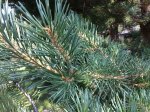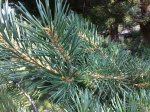We all want that mountain top wind and snow beaten 300 year old yamadori. But here I am looking a gift horse in the mouth. This one seems to be a very leggy Mugo (please correct me if I'm mistaken) planted in the wrong place years ago. It's gamely fighting a losing battle to get to the sun. So I'll be removing it. It's 95 here with bone dry soil, so I plan on digging it next spring.
It's gamely fighting a losing battle to get to the sun. So I'll be removing it. It's 95 here with bone dry soil, so I plan on digging it next spring.
 Its about 10' high and wide with a 3"+ trunk at the base. I can do a trunk chop now and hope that the entire root system pushes back budding in a shady location or do it with the dig next spring. Thoughts? Comments?
Its about 10' high and wide with a 3"+ trunk at the base. I can do a trunk chop now and hope that the entire root system pushes back budding in a shady location or do it with the dig next spring. Thoughts? Comments?
 It's gamely fighting a losing battle to get to the sun. So I'll be removing it. It's 95 here with bone dry soil, so I plan on digging it next spring.
It's gamely fighting a losing battle to get to the sun. So I'll be removing it. It's 95 here with bone dry soil, so I plan on digging it next spring.
 Its about 10' high and wide with a 3"+ trunk at the base. I can do a trunk chop now and hope that the entire root system pushes back budding in a shady location or do it with the dig next spring. Thoughts? Comments?
Its about 10' high and wide with a 3"+ trunk at the base. I can do a trunk chop now and hope that the entire root system pushes back budding in a shady location or do it with the dig next spring. Thoughts? Comments?







